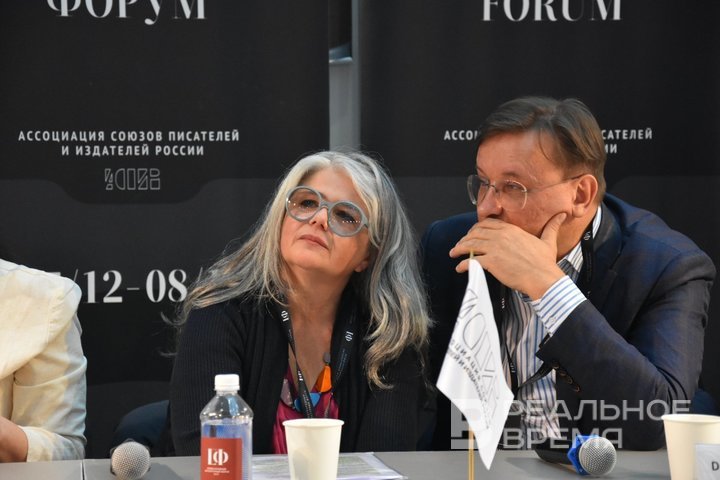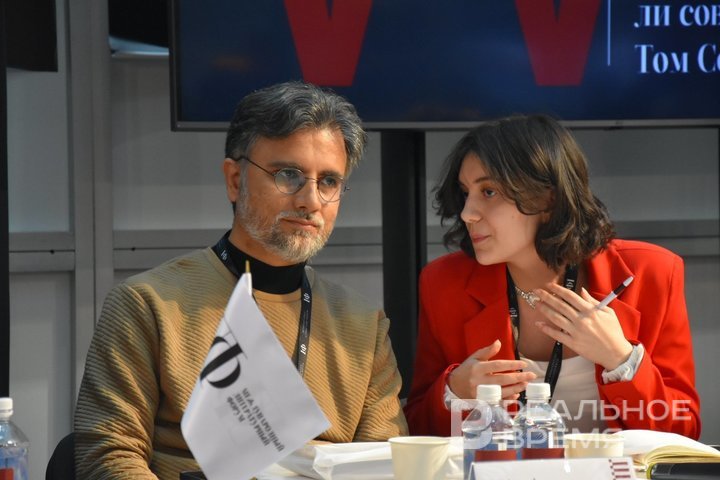Contemporary children’s literature: to educate or entertain?
How to bring a child back to books in the screen era — representatives of the book industry discussed this at non/fiction№26 International Fair of Intellectual Literature

The question that parents, publishers and writers around the world ask themselves is: how to make children pick up a book again, and not a smartphone? Experts from Russia, Iran and Italy discussed this topic at the discussion at non/fiction№26 International Fair of Intellectual Literature.
“For some reason, we deny children what we use ourselves”
Writer, translator and critic Mikhail Vizel began with a fundamental question: is it possible to distinguish “contemporary literature” at all? Natalia Kostyushina, head of the Centre for Bibliography and Children's Literature at the Russian State Children's Library, is confident that the concept of “modernity” in literature is a changeable category. “Today, any particular book is modern because it turned out to be good and entered the pool of eternal books, became a classic. But this category is floating. The language has changed, time has changed, some things have gone, some have remained,” Kostyushina noted. According to the speaker, children's literature invariably includes two principles — entertainment and education. It all begins with nursery rhymes and ditties, through which the child learns to interact with the world. However, adults, according to Kostyushina, often focus exclusively on the educational side. “They always think that any children's book is obliged to teach something. For some reason, we deny children what we use ourselves. When we are tired, we take a light book to rest. For some reason, children are denied this. Although, I think there should be books that simply entertain. They can be funny, light and do not have to teach and edify all the time,” she emphasised.

Anastasia Orlova, a children's poet, writer and publisher, supported the thesis that children's literature “does not have to do anything.” “If the author's soul asks to entertain, then, please, you can entertain. If you want to write an educational book — why not? Literature itself is already interaction, contact. It is a close, intimate field between parent and child. This is what creates a common context that will connect them forever,” Orlova said. She also recalled her experience as a young mother, when she was looking for books that could not only captivate her child, but also give new knowledge. She tries to implement this approach in her own work, weaving educational elements into the plots.
Writer Sofia Remez added to the conversation about the educational and entertaining role of the book the idea of the importance of the reading process itself. “Reading is a slow activity in the modern world. You focus on the book, spend time and energy on it. And even if you just discuss it with your parents later, the effect will definitely be educational,” Remez noted. In addition, she emphasized that the book develops empathy, allowing you to live through someone else's experience and understand the feelings of other people.
Italian writer and illustrator Daniela Pareschi drew attention to the visual component of children's books. She said she is both a writer and an illustrator, and she has two weapons. She can charm through images and at the same time provide educational elements in the text. So she is called a writer who conveys complex meanings simply through illustration, Pareschi shared.
Children's literature in competition with gadgets
According to Daniela Pareschi, illustrations are becoming an important tool for keeping children's attention in a world full of distractions. In Italy, the quality of the visual part is given great importance: the illustration becomes an anchor that helps the child concentrate and allows parents to create a common point of contact with him. No screen can replace the unity that is created by reading together with a child, Pareschi stressed.

The main weapon of a book is the power of the image, the Italian writer is sure. When asked by Mikhail Vizel about the impact of digitalisation on children's literature, she answered that, indeed, it has its impact, but the main thing is to transfer known concepts and situations to a new context. This helps to perceive them in a new way. In Italy, publishers understand that if you treat a children's book as a work of art, invest effort and money in the quality of illustrations, there will be a market for it. This strategy works: in Italy, even the youngest readers appreciate the visual component of books. Illustrations become not only decoration, but also a way of learning. According to Pareschi, such publications teach children to concentrate and to perceive information thoughtfully.
Modernising classics: the Iranian approach
In Iran, classical literature remains the basis of education, but it requires adaptation. Ali Asgari, a publisher from Tehran, spoke about his strategy at his publishing house: “Classical works are difficult for children to understand. We modernise them, adapt them to modern reality. For example, the collection Shahnameh. Its ancient language is difficult even for adults. We created a version with humour and modern elements that is accessible to children.” But working with classics is not limited to local works. Asgari added that translations are also published: “We publish books by Dostoyevsky, Jules Verne, Mark Twain. The popularity of such books in Iran remains high.”

Shiva Azimiramezani, who also represents Iran, emphasised the importance of classics in developing skills. Her publishing house is actively working on rethinking traditional plots: “Reading classics is a way to connect with the past and realize that, despite the development of society, human nature remains unchanged. We raise the topics of love, identity and self-discovery. Our books help children and adults develop language skills.” Azimiramezani highlighted the importance of combining high-quality text and illustrations: “This is the key to success. Especially in the digital age, where it is difficult to hold children's attention.”
Problematic topics: bullying, harassment and taboos
Modern children's literature faces the question: is it possible to talk to young readers about complex and “uncomfortable” topics? Sofia Remez recalled the legislative restrictions in Russia: “We have a law on the protection of children from information (Federal Law 436). It sets the framework, and some topics, whether in demand or not, are simply prohibited from being raised in books.”
The situation is different in Italy. Pareschi noted that there are no restrictions in Italy. Books for toddlers and 18+ comics can be found on the shelves next to each other. We are quite liberal. But this does not mean that topics such as bullying are presented without filters. The main thing is to talk about them in a way that helps, it doesn’t traumatise.
Each country has its own strategies for fighting for the attention of young readers. But the key conclusion is clear: for children to read, books must be interesting, accessible and beautiful. In the age of technology, it is a creative approach that can return literature to its leading role.
Ekaterina Petrova is a book reviewer of Realnoe Vremya online newspaper, the author of Poppy Seed Muffins Telegram channel and founder of the first online subscription book club Makulatura.